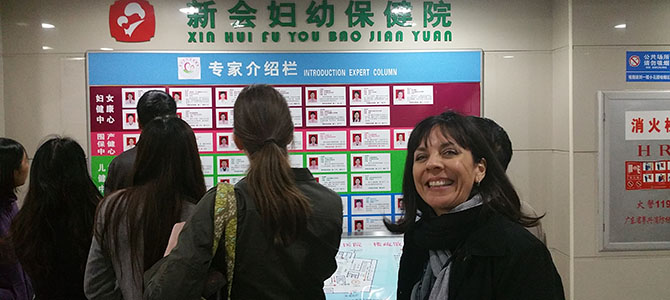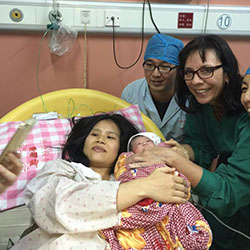
UA Doctor Trains Obstetricians in China

Maria Manriquez, MD, spent the first week of December delivering babies in China.
Her trip was part of the “No Pain Labor & Delivery” Global Health Initiative meant to introduce Chinese physicians, anesthesiologists and patients to epidural anesthesia during delivery.
The goal of the initiative is to reduce the cesarean delivery rate in China, which is among the highest in the world, by educating medical staff about neuraxial labor analgesia, more commonly known as an epidural. Ling Qun Hu, MD, assistant professor of Anesthesiology at Northwestern University, started the program in 2006 and since then, teams of doctors, anesthesiologists and labor and delivery nurses have traveled to China to establish obstetric anesthesia training centers.
During her Dec. 1-9 trip, Dr. Manriquez, director of the Obstetrics-Gynecology clerkship at the University of Arizona College of Medicine – Phoenix, performed two cesarean section deliveries and two vaginal deliveries. One of her successes was convincing the CEO of the Xinhui Maternity and Child Health Care Hospital to allow a father into the delivery room, and he was able to cut the umbilical cord of his newborn. Normally, husbands are not present in delivery rooms in China, she said.

In addition to delivering four babies, Dr. Manriquez lectured about the advantages of epidurals and instructed during delivery simulations. Among the reasons for the high c-section rate in the country is that many anesthesiologists have not had much experience using epidural analgesia, and some obstetricians fear the effects on the fetus. Also, for cultural reasons, many Chinese parents want to choose the date and hour of their child’s birth, because certain numbers are luckier than others.
“The visit and opportunity to experience and work with colleagues of another country and culture was one of the highlights of my career,” Dr. Manriquez said. “I was able to communicate based on the common language (using hand signals) in the operating room and, of course, a great interpreter colleague.”
Organizers of the No Pain Labor & Delivery initiative say the rate of cesarean deliveries has declined by as much as 20 percent since the program started.
Dr. Manriquez said she believes that with time, if protocols of massive blood transfusion and donor programs similar to those in the U.S. become the norm in China, “the use of regional anesthesia and willingness to trial of labor after a cesarean section will be more desirable than it is currently.”
Dr. Manriquez and Rebecca Fisher, Director of the College’s Gross Anatomy Lab, designed a curriculum for OB-GYN students that allows them to apply their knowledge in a surgical perspective by returning to the anatomy lab during their third- and fourth-years. In addition to her OB-GYN clerkship duties, Dr. Manriquez is the director of the College’s Pathway Scholars Program, designed for students who have experienced unique or greater than average challenges in preparing to become competitive medical school applicants.
Media Contact:
Marian Frank
Phone: 602-827-2022
Topics
About the College
Founded in 2007, the University of Arizona College of Medicine – Phoenix inspires and trains exemplary physicians, scientists and leaders to advance its core missions in education, research, clinical care and service to communities across Arizona. The college’s strength lies in our collaborations and partnerships with clinical affiliates, community organizations and industry sponsors. With our primary affiliate, Banner Health, we are recognized as the premier academic medical center in Phoenix. As an anchor institution of the Phoenix Bioscience Core, the college is home to signature research programs in neurosciences, cardiopulmonary diseases, immunology, informatics and metabolism. These focus areas uniquely position us to drive biomedical research and bolster economic development in the region.
As an urban institution with strong roots in rural and tribal health, the college has graduated more than 1,000 physicians and matriculates 130 students each year. Greater than 60% of matriculating students are from Arizona and many continue training at our GME sponsored residency programs, ultimately pursuing local academic and community-based opportunities. While our traditional four-year program continues to thrive, we will launch our recently approved accelerated three-year medical student curriculum with exclusive focus on primary care. This program is designed to further enhance workforce retention needs across Arizona.
The college has embarked on our strategic plan for 2025 to 2030. Learn more.